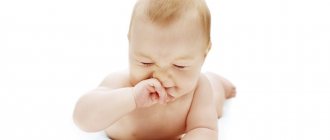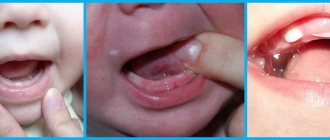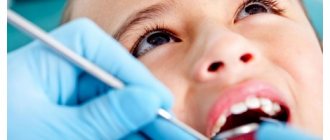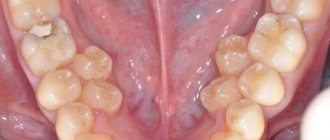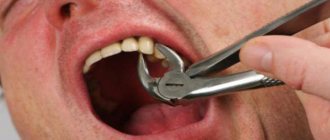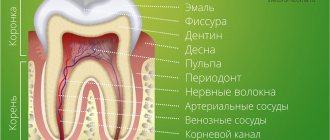The time when a child is cutting his adult teeth is one of the most serious and difficult periods of his development. To help the baby survive it without problems, parents need to know what symptoms indicate the eruption of molars, and how to help the child in this situation.
Teething of molars in children: symptoms
Molar milk teeth
What do parents need to know about baby teeth?
- Deciduous incisors, like permanent incisors, have a root.
- The rudiments of such dental units are formed in the prenatal period.
- When a temporary tooth is replaced by an adult one, the old root eventually resolves on its own.
- On the first teeth the enamel is softer.
- Baby teeth are smooth and have wide roots to provide room for the development of permanent tooth buds.
- Temporary teeth are canines and lateral incisors, central and first molars, premolars. The second molars in four-year-old children are already adults.
Baby teeth
When the rudiments of an adult tooth appear, the root of its predecessor weakens and the tooth becomes loose. If it is not pulled out, an adult tooth may be visible underneath it. When milk interferes with it, it can grow with deviations from the norm.
The dentition is symmetrical in nature, and teeth erupt in pairs: on both parts of the dentition they appear almost simultaneously.
The structure of baby teeth
Video: Eruption of molars in children - important nuances
Timing of adult teeth eruption
The rudiments of the first teeth (on average, about 20 units) in infants are formed during the first two years of life. When the time comes to replace them with permanent teeth, the milk teeth become loose and fall out. There are no specific dates for the eruption of molars; many factors can affect the speed: environmental conditions, climate, water quality and diet. Genetic characteristics also play a certain role, some of which make themselves felt even during the formation of the fetus. The influence can be both positive and negative. If parents have healthy teeth from birth, then you don’t have to worry about the child’s teeth. If the first incisors, canines and premolars grow in 3 years, then the permanent ones take a long time to erupt. The first symptoms of dentition change can be seen at the age of 5, and it continues until the age of 21, when the third molars appear.
Video: Timing of eruption of permanent teeth
Timing of eruption
Typical problems.
The formation of the dentofacial system in this age range usually proceeds without any problems. At the age of 12, not a single baby tooth remains in the oral cavity, which makes this period the most favorable for orthodontic treatment with braces. By the age of 15, jaw growth begins to slow down, which is why it is advisable to carry out any orthodontic treatment before this age, as it allows you to do without tooth extraction.
PHOTO: Teeth of a 14-year-old teenager. There are 28 teeth in the mouth.
If there was an early removal of primary chewing teeth and no appropriate correction was carried out, there is a lack of space in the dentition for the eruption of permanent premolars and canines. Since the canine is the last one to erupt, it is the one that will not have enough space. Crowding of teeth is formed in the anterior part of the jaws: in this situation, fangs can erupt outside the dental arch closer to the lip.
If the wisdom tooth germ is incorrectly positioned in the lower jaw, existing crowding of teeth may form or worsen. By exerting pressure on a nearby tooth (second molar), it leads to a displacement of the entire dentition in the anterior direction. Complete eruption of an incorrectly positioned “Wisdom tooth” is not possible (there is not enough space for it in the dentition). Incomplete eruption (retention) of the “Wisdom tooth,” in turn, leads to deterioration of hygiene in this area and the rapid development of the carious process both on the 8th tooth and on the adjacent second molar.
Signs of formation of permanent teeth
The most characteristic symptom of the formation of adult teeth in childhood is the growth of jaw size. The gaps between the first teeth are small; if the jaw grows, this means that it creates conditions for new dental units. Adult teeth are larger than temporary teeth, so they require a lot of space. The distance between baby teeth increases. They lose stability and fall out. With any deviations, the teeth will break through with pain, bend, and ruin the bite. In order for a child’s teeth to grow correctly, parents need to control this process.
Pay attention to the distance between your child's teeth
Permanent teeth can erupt at 6-7 years of age without any symptoms, but most often the child behaves restlessly, is capricious, gets irritated over trifles, and eats poorly. Often the formation of permanent teeth has the same signs as during the eruption of milk teeth. If other diseases occur during teething, they can distort the symptoms.
- How to make teething easier for babies
Permanent teeth erupt at 6 or 7 years of age
Increased secretion of saliva is a very common symptom, although it is no longer as abundant as in infancy, but the difference can be noticed. At the age of 6, children can already be taught to wipe their mouth with a napkin, otherwise irritation will appear on the face, since saliva contains many microbes that aggressively affect delicate skin.
If your child is drooling, have a supply of clean tissues ready.
During the period of growth of permanent teeth, the gums and mucous membranes become inflamed again. If you notice redness in the mouth, it is better to show the child to a dentist, who can accurately distinguish the beginning of teething from a banal viral infection.
Take your child to the dentist if you notice redness in your child's mouth
Over time, swelling is observed on the gums - this is an adult tooth making its way to replace the temporary one. The germination process is painful; parents can alleviate the child’s condition with anesthetics.
Pain is replaced by itching. The child pulls any things to his mouth to soothe his gums.
The child may suck or chew fingers or other objects
A natural symptom will be deterioration in sleep quality. If he is bothered by toothache, the baby will not be able to fall asleep for a long time, often wakes up at night, cries, and tosses and turns.
If your baby is having difficulty sleeping and crying, this could be a symptom of teething.
Some children develop a fever, cough, and upset stool.
Fever and cough may appear
The listed signs may appear periodically and do not necessarily have to be present in all children.
Possible problems with deviations from the norm
Complete edentia is a case when teeth are completely absent.
Regardless of the fact that the molars have just appeared or are about to erupt in the mouth of their beloved child, parents should be vigilant, because there are many dental problems. The main issue is the delay in the growth of permanent teeth (a baby tooth has fallen out, but a new one has not appeared).
The reason may lie in a genetic predisposition or edentia, which arose due to a violation of the formation of rudiments during intrauterine development. If there is no way to influence the situation, the child is indicated for prosthetics.
When permanent teeth erupt, another problem may arise – pain. This is most often due to thin, not fully formed enamel, which does not have sufficient mineralization. It is at this stage that the tooth is susceptible to various diseases, in particular caries.
With deep destruction of dental tissues, even more serious diseases develop: pulpitis, periodontitis. Therefore, you cannot ignore a child’s toothache; you need to make an appointment with a pediatric dentist as soon as possible.
At the very beginning of the growth of permanent teeth, other problems can occur:
- loss of a root unit is a signal of serious problems with the child’s health;
- an increase in the level of trauma - the active lifestyle of children during the period of maturation of molars often leads to injury to the incisors and canines, and attempts to chew hard objects end in the breakage of molars and premolars.
Each case requires the intervention of a specialist to eliminate the negative consequences.
The order of appearance of adult teeth
Almost all milk teeth that erupted in the first two and a half years, 10 on each half, are replaced by permanent ones. Compared to their predecessors, adult teeth form in a different order.
Table. The order of formation of permanent teeth
| Tooth name | Development timeframe | Peculiarities |
| Lower and then upper molars | This usually occurs in the seventh year of life | They make their way behind the second primary molars |
| Molar lateral | This can take three years – from 6 to 9 years old | They sprout when the central incisors are already formed |
| Permanent fangs | Normally, this occurs between the ages of 9 and 11 years. | By cutting the gum from the inside, they seem to displace milk precursors |
| First and second adult premolars | Appears at 10-13 years of age | They grow in place of central incisors, which become loose and fall out. |
| Third molars, better known as wisdom teeth | They may erupt at 18 years old, or at 25, or not at all. | Such cases are not considered a deviation from the norm. |
If a baby's individual teeth grow in a different order, this is not dangerous. Individual characteristics, deficiency of vitamins and minerals slow down the speed and sequence of formation of permanent teeth. It is important for parents to know that an adult tooth should not become loose; if there are similar symptoms, this should be a reason to visit the dentist.
- Teething in children: sequence up to one year
Teeth may fall out and grow in random order in different children
Permanent teeth should not be loose
Eruption of permanent teeth in children: timing and features
As a rule, this process begins at 5–6 years with the first molar. Frankly speaking, a panoramic X-ray of the jaw at this age looks somewhat unusual, since three rows are clearly visible on it: the first contains the milk teeth, the second contains individual molars at various stages of development, and the third contains the molars.
In most cases, by the age of 12–13 years, the replacement of the bite from temporary to permanent ends. But at the same time, the root system is not fully formed; usually this process lasts up to 15–16 years. In addition, within three years after eruption, intensive mineralization of the enamel occurs, then its rate changes depending on the influence of both external and endogenous (internal) factors. The content of mineral components is constantly increasing (subject to proper nutrition and oral care) and is considered “mature” only by the age of 18.
Approximate timing of bite change
It is not so easy for a non-specialist to decipher the dental formula, and if the difference between, for example, incisors and canines is obvious, then it is not always possible to understand molars and premolars. Therefore, for convenience, the dentition is designated by numbers from one to eight, starting from the central incisors to the left and, accordingly, to the right.
Like baby teeth, molars in children appear symmetrically in the following sequence:
- “ones” (central incisors): 6–8 years;
- “twos” (lateral incisors): approximately at 7 years old on the lower jaw and at 8–9 years old on the upper jaw;
- “threes” (fangs): at 10 years old from below and at 11–12 years old from above;
- “fours” and “fives” (first and second premolars, respectively): 10–12 years;
- “sixes” (first molars): 6–7 years, with root formation ending at best four years later;
- “sevens” (second molars): 11–13 years.
Special mention should be made about the eruption of “eights,” third molars, better known as “wisdom teeth.” The timing of their appearance varies. For some it is 19–20 years old, for others much later. There are cases when “eights” are completely absent. However, in such a situation, mandatory x-rays and consultation with a dentist are recommended. Sometimes they develop incorrectly, grow inside the gums, compress adjacent tissues, which leads to significant problems with the bite and, as a result, the aesthetics of the smile.
Associated symptoms
When the bite changes, the following are observed:
- Pain. Discomfort occurs as soon as a baby tooth begins to loosen. While eating, it is sometimes painful for a child to chew food, and discomfort also occurs when pressing on the gums in this area.
- Swelling and swelling , redness of the gums.
- Increase in body temperature up to 38–38.5°. As a rule, hyperthermia occurs during the eruption of molars.
- General malaise. Often a child, especially of preschool age, cannot talk about his feelings, so deterioration in health is accompanied by moodiness, lack of appetite, irritability, and tearfulness.
Associated symptoms
These symptoms do not appear very often, but they cannot be ignored. If the baby has a fever, an incomprehensible cough, or diarrhea, this can be either a sign of infection or a reaction of a weakened body to pathogenic microflora.
Diarrhea can be a sign not only of teething, but also of various diseases
When teeth are forming, the temperature usually lasts for 3-4 days at 38.5°C. This symptom is irregular, so fever in children should be periodic. If it persists for a long time, you need to show the child to the pediatrician. Some doctors believe that cold symptoms have nothing to do with teething and prescribe appropriate treatment for cough and fever.
If the temperature lasts longer than three days, you should consult a doctor.
Adults also don’t understand what cough and runny nose have to do with new teeth. The gums are directly connected to the blood supply to the nose and respiratory tract. As teeth form, blood flow increases in the mouth. The nasal mucosa is close, so its glands also begin to produce more mucus, which children try to get rid of. Remaining mucus settles into the throat, irritating the airways and causing a cough.
A runny nose may occur when teething
Another symptom is loose stools with a frequency of no more than 3 times a day. While scratching his gums, the baby constantly puts dirty fingers and the first objects he comes across into his mouth. In addition to infection, diarrhea is facilitated by increased salivation, which constantly flushes the intestines. If the stool is short-lived and does not contain blood, there is no need to worry about the child’s health. It is necessary to monitor his condition, since with a weakened immune system there is always a risk of developing an infection, which aggravates all the symptoms.
When is there a reason to visit the dentist?
The formation of the dentition requires constant monitoring and competent assistance from the parents to the child, so that in case of developmental deviations, pathology is noticed in time.
- Teething in children: how to relieve pain
It is good if, when the first permanent teeth appear, the child visits the pediatric dentist for preventive purposes.
Such an examination will help identify a number of problems:
- malocclusion;
- gum disease;
- inadequate mineralization of enamel;
- curvature of the dentition;
- milk caries.
Malocclusion
Caries of baby teeth
Insufficient attention to teeth in childhood means not only excruciating pain, tears and insomnia for the whole family, but also painful treatment and fear of the dentist for life. Therefore, it is important to constantly maintain contact with your doctor and devote enough time to the health of your children.
Losing the first teeth is a natural process for all children. And you only need to worry when problems arise with the formation of adult teeth. They can be prevented if the eruption of the first tooth is controlled. Jaw hurts after tooth extraction, you will find the answer in the link.

